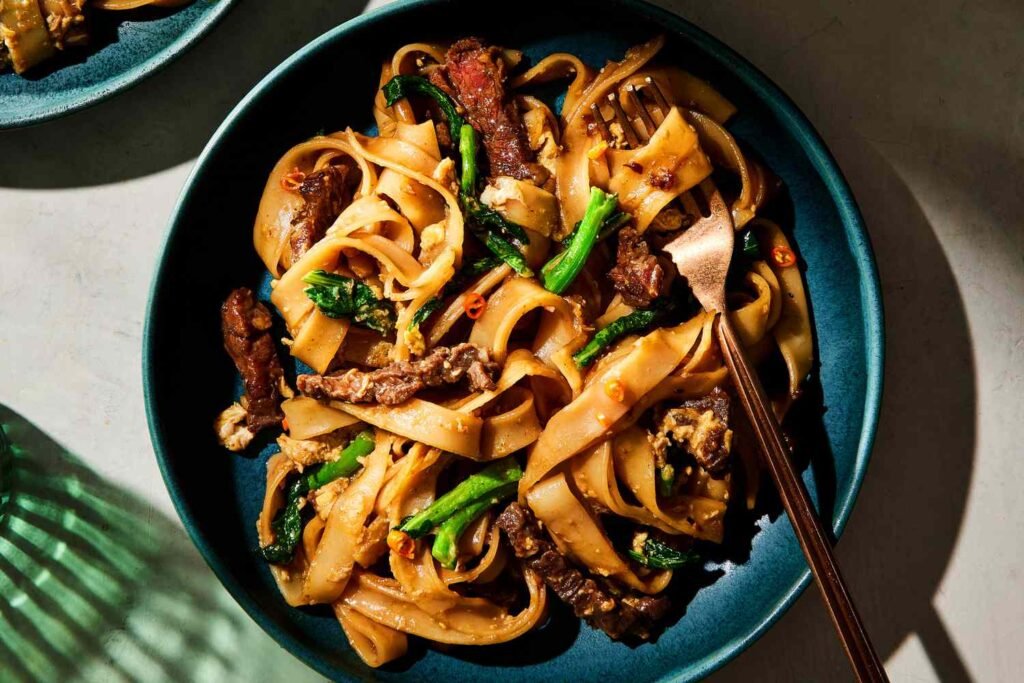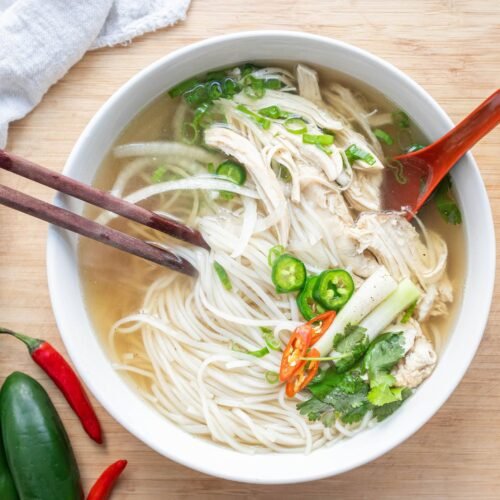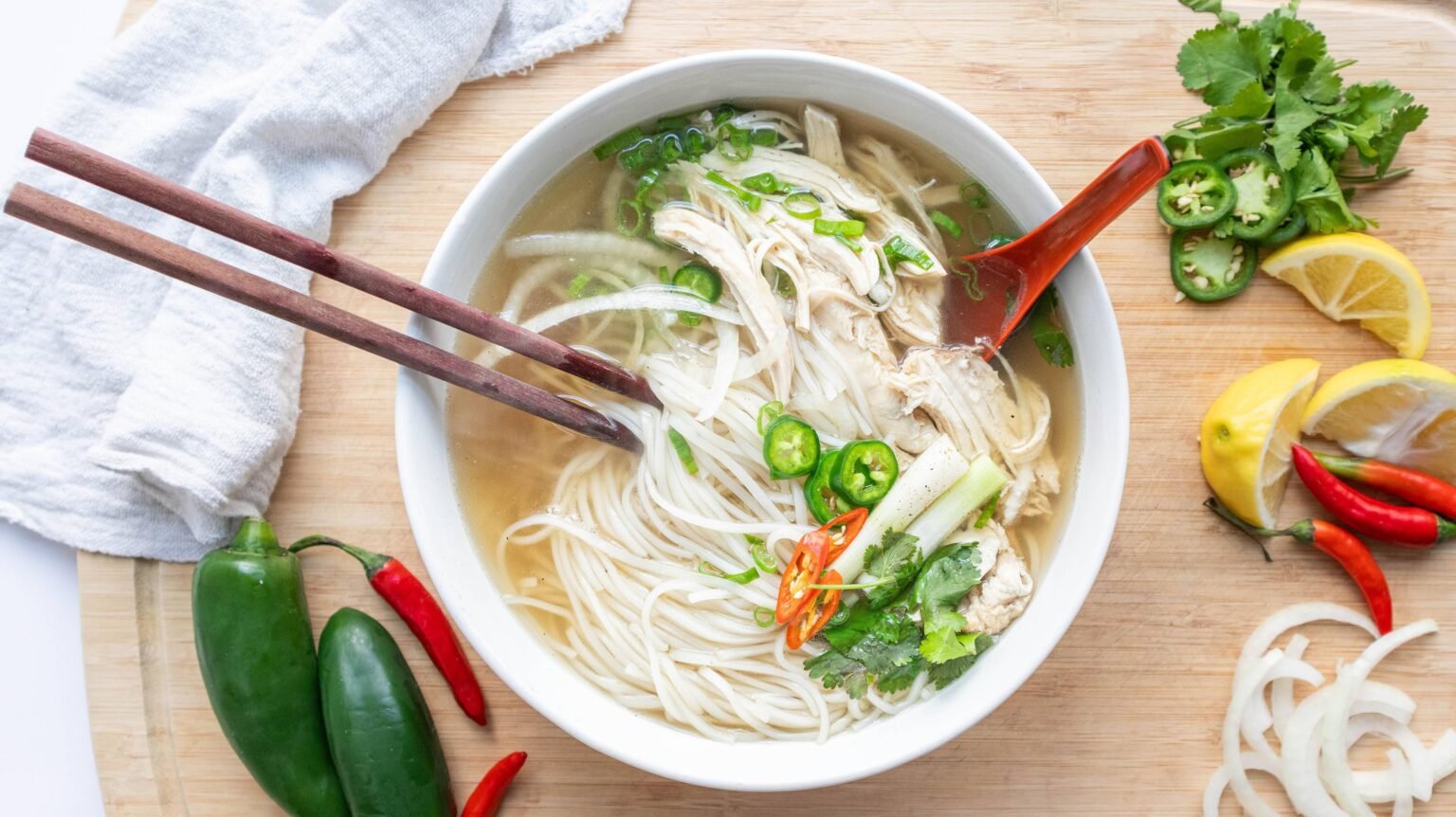Staring at a bowl of leftover pho noodles and wondering what magic you can whip up with them? You’re not alone. Transforming these strands into delightful dishes is simpler than you might think.
From quick stir-fries to inventive salads, I’ve got the scoop on turning last night’s dinner into today’s masterpiece. If you’re looking for inspiration, I promise, the next few paragraphs hold some tasty secrets.
1. Fried Noodles

Transforming your leftover pho noodles into a stir-fried delight is a straightforward and satisfying option. Here’s how you can revamp those noodles into something special.
Firstly, gather your ingredients:
- Oil: Choose a neutral oil with a high smoke point, such as canola or vegetable oil.
- Vegetables: Slice up any favorites you have, like bell peppers, carrots, or snap peas, for a crunchy texture.
- Protein: Have any cooked chicken, beef, or tofu ready to add substance to your dish.
- Sauce: Soy sauce or oyster sauce will bring a rich, savory element to the noodles.
- Leftover pho noodles: Ensure they are at room temperature to prevent clumping when cooking.
Instructions:
- Heat Your Pan: Place your pan on medium-high heat and pour in some oil, letting it warm up to prevent sticking.
- Sauté Vegetables & Protein: Add in your sliced vegetables and chosen protein. Cook until they’re browned and almost cooked through.
- Noodles & Sauce: Stir in the leftover pho noodles, followed by a few splashes of your preferred sauce. Keep everything moving in the pan to evenly coat the noodles and prevent burning.
- Serve Immediately: Once your noodles are heated through and have absorbed the flavors of the sauce, it’s time to enjoy your reinvented meal!
Consider garnishing with fresh herbs like cilantro or basil, or a squeeze of lime juice for extra freshness.
Remember to adjust the heat as needed and add sauce cautiously; you can always add more but you can’t take it away. Enjoy your newly crafted fried pho noodles!
2. Instant Pot Beef Pho

If you find yourself with leftover pho noodles, Instant Pot Beef Pho is a timesaving solution that’ll turn your surplus into a delectable meal. Here are the essentials you’ll need to start:
- Beef Bones: Mixed beef bones such as oxtail or neck bones will form a rich base for your broth.
- Aromatics: Ginger and onion, when charred, add a smoky flavor to your broth.
For the broth, rinse the beef bones, and sauté ginger and onion until charred. Add your bones along with spices such as star anise and cinnamon to your Instant Pot. Cover with water, then cook under high pressure for about an hour.
Let’s talk spices and seasoning:
- Star Anise
- Cinnamon
- Cloves
| Quantity | Ingredient |
|---|---|
| To taste | Salt |
| To taste | Fish sauce |
| As needed | Water |
For a deeper dive into the recipe, visit this guide on Instant Pot Beef Pho.
Once your broth is aromatic and deeply flavored, strain it, and bring to a simmer. Take your leftover pho noodles and add them to the broth until they’re heated through.
Assembling your bowl:
- Place warmed noodles in a bowl.
- Ladle the hot broth over the noodles.
- Thinly slice beef of your choice (raw or cooked) to top your dish.
- Customize with garnishes like basil, cilantro, lime, and bean sprouts.
Remember, the key to a tantalizing bowl of pho is balance – the rich broth, tender meat, and the lightness of fresh herbs and sprouts.
Enjoy your homemade Instant Pot Beef Pho, a filling dish that brings Vietnamese flavors to your table with ease.
3. Noodle Stir-Fry

If you have leftover pho noodles, turning them into a noodle stir-fry is a brilliant way to repurpose them into a flavorful and satisfying meal. The following steps guide you through creating your own noodle stir-fry:
- Prepare Your Ingredients:
- Gather vegetables like bell peppers, broccoli, and carrots.
- Slice a protein choice such as chicken, beef, or tofu.
- Have soy sauce, oyster sauce, or hoisin sauce at hand for seasoning.
- Prep the Noodles:
- Make sure your pho noodles are at room temperature.
- If they’re clumped together, rinse briefly under warm water to separate them.
- Cook in Stages:
| Step | Action |
|---|---|
| 1 | Start with a large pan or wok over high heat and add a tablespoon of cooking oil. |
| 2 | Add your sliced protein and cook until it’s done. Remove and set aside. |
| 3 | In the same pan, toss in your vegetables and stir-fry until they’re just tender. |
| 4 | Reintroduce the protein to the pan with the vegetables. |
| 5 | Add the leftover pho noodles. |
| 6 | Pour in 2-3 tablespoons of your chosen sauce to add a rich flavor. |
| 7 | Stir everything together well, ensuring the noodles get coated with the sauce and heat through completely. |
Optional: Add a sprinkle of sesame seeds or chopped green onions for an extra layer of texture and taste.
By following these steps, you’ll transform your leftover pho noodles into a delicious noodle stir-fry that’s both quick and easy.
Enjoy your inventive and delectable meal!
4. Asian Noodle Salad

Turning your leftover pho noodles into an Asian Noodle Salad is a fantastic way to repurpose them into something new and exciting. This dish is characterized by its fresh, vibrant flavors and diverse textures. Below is the guide to create a delightful Asian Noodle Salad with your leftover noodles.
Ingredients:
- Leftover pho noodles
- Julienned carrots
- Sliced cucumbers
- Chopped cilantro
- Thinly sliced red bell peppers
- Optional: Shredded chicken or tofu for protein
- For the dressing:
- 3 tablespoons rice vinegar
- 1 tablespoon soy sauce
- 1 tablespoon sesame oil
- 1 teaspoon honey or sugar
- 1 minced garlic clove
- Optional: A pinch of chili flakes for some heat
Instructions:
- Prepare the Vegetables: Julienned carrots, sliced cucumbers, thinly sliced red bell peppers, and chop the cilantro. Set aside.
- Make the Dressing: In a small bowl, whisk together rice vinegar, soy sauce, sesame oil, honey or sugar, and minced garlic. Add chili flakes if desired.
- Toss the Salad: In a large bowl, combine the vegetables with the leftover pho noodles. Pour the dressing over the top and toss everything to combine well.
- Add Protein (Optional): Incorporate shredded chicken or tofu to add a protein boost.
This Asian Noodle Salad is not only a healthy choice but also a quick solution for lunch or a light dinner.
The dressing adds a tangy flavor that complements the cool crunch of the vegetables, making it a satisfying meal any day of the week.
Enjoy your Asian Noodle Salad as a standalone dish or as an accompaniment to grilled meats. Its versatility makes it a hit for any occasion.
5. Summer Rolls

If you have leftover pho noodles, consider making summer rolls, a fresh and light option that is perfect as an appetizer or a healthy snack.
Summer rolls, also known as rice paper rolls, are a versatile dish that can embrace a variety of fillings including vegetables, herbs, and proteins.
Ingredients:
- Leftover pho noodles
- Rice paper wrappers
- Fresh herbs (mint, basil, cilantro)
- Crisp vegetables (lettuce, cucumber, carrots, bell peppers)
- Optional: cooked shrimp, chicken, or tofu
Instructions:
- Prepare the Filling:
- Julienne the vegetables into thin, matchstick-sized pieces.
- Slice the optional protein if you’re adding any.
- Soften the Rice Papers:
- Dip rice paper wrappers into warm water for a few seconds until pliable.
- Lay the wrapper flat on a clean, damp surface.
- Assemble the Rolls:
- Place a small handful of pho noodles onto the center of the wrapper.
- Add the herbs, vegetables, and protein on top of the noodles.
- Wrap the Rolls:
- Fold in the sides of the wrapper, then roll tightly, just like a burrito, securing the ingredients inside.
Tips:
- Avoid overstuffing to prevent tearing.
- Keep a bowl of water handy to keep your fingers moist, which helps prevent sticking.
For a delicious pairing, serve your summer rolls with a peanut dipping sauce or a traditional fish sauce-based dip.
This is a great way to repurpose your leftover pho noodles into something refreshingly different, while still maintaining a balanced and vibrant meal.
6. Pad See Ew

Transform your leftover pho noodles into a delightful Pad See Ew. This Thai dish is a popular option for its bold flavors and straightforward preparation.
Begin by finding the essential Pad See Ew ingredients. You’ll need dark soy sauce for its color and flavor, and light soy sauce for seasoning. Your leftover pho noodles, typically rice noodles, are perfect for this recipe, offering a familiar taste and texture.
Ingredients:
- Leftover pho noodles
- Dark soy sauce
- Light soy sauce
- Chicken or tofu, bite-sized
- Egg
- Chinese broccoli or similar greens
- Garlic, finely chopped
- Vegetable oil
Instructions:
- Prepare your ingredients: Slice your protein into bite-sized pieces. Also, wash and chop the Chinese broccoli, beat the eggs lightly, and mince your garlic.
- Cook the protein: Heat oil in a wok or large frying pan. Then, add the garlic and sauté until golden. Add your choice of protein and stir until it’s cooked through. Push to the side.
- Eggs and noodles: In the same pan, add beaten eggs and scramble slightly. Then, mix in the noodles, ensuring they soften and heat up evenly.
- Sauce and greens: Incorporate both soy sauces, followed by the Chinese broccoli. Stir until the greens are cooked to a bright green yet still tender.
For textures akin to authentic Thai recipes, ensure a balance of flavors and cook on high heat for that characteristic ‘wok hei’—a sign of a well-made stir-fry. Savor every bite of your creatively repurposed noodles with this simple yet delicious Pad See Ew.
7. Pho Ap Chao

If you have leftover pho noodles, transforming them into a delicious Pho Ap Chao is a fantastic way to give them new life. Pho Ap Chao, a crispy stir-fried noodle dish, is a delightful blend of textures and flavors, using the leftover noodles from your pho meal.
To begin, you’ll need:
- Leftover pho noodles
- Vegetables (like broccoli, bell peppers, and onions)
- Protein (such as beef, chicken, or tofu)
- Soy sauce, oyster sauce, and other stir-fry seasonings
Here’s a quick guide to prepare Pho Ap Chao:
- Dry the noodles: Lay the leftover pho noodles out on a paper towel to remove excess moisture.
- Prep your ingredients: Slice your protein and vegetables into bite-sized pieces for even cooking.
- Stir-fry the protein: In a hot pan, quickly stir-fry your chosen protein until it’s cooked through and set aside.
- Vegetables: Add the vegetables to the pan and sauté until just tender.
- Combine and crisp: Return the protein to the pan with the noodles, add sauce to taste, and stir-fry until the noodles are crispy on the edges.
For a detailed recipe and cooking times, refer to this guide on how to prepare Pho Ap Chao. Remember to adjust the heat to prevent the noodles from sticking and stir continuously for that perfect crispy texture. Enjoy your Pho Ap Chao as a savory, crispy dish that’s sure to satisfy.
How can leftover pho noodles be used in a healthy recipe?
What are some creative ways to repurpose leftover cooked rice noodles?
How long are cooked pho noodles good for when stored in the refrigerator?
Can leftover pho noodles be frozen for later use?
What is the best method for frying leftover pho noodles to achieve crispiness?
Are there any unique recipes for mixing fried rice with leftover pho noodles?

7 Creative Leftover Pho Noodles Recipes
Ingredients
- Fried Noodles: Stir-fry the noodles with vegetables a protein of your choice (such as chicken, beef, or tofu), and a savory sauce. Add ginger and green onions for extra flavor
- Instant Pot Beef Pho: Use the noodles as a base for a quick homemade beef pho taking advantage of the Instant Pot to speed up the broth-making process
- Noodle Stir-Fry: Create a simple stir-fry with leftover vegetables a protein source, and a sauce made from soy sauce, sesame oil, and a touch of sugar. This can be a quick and nutritious meal
- Asian Noodle Salad: Toss the noodles with cut vegetables like carrots, bell peppers, and cucumbers, fresh herbs (mint or cilantro), and a light dressing made from lime juice, fish sauce, and a bit of sugar. Top with crushed peanuts for crunch
- Summer Rolls: Soften rice paper wrappers and fill them with noodles shrimp or tofu, lettuce, and herbs. Serve with a peanut or hoisin dipping sauce
- Pad See Ew: Use the noodles to make this Thai dish stir-frying them with soy sauce, a bit of sugar, and Chinese broccoli or regular broccoli, adding either chicken, beef, or tofu as the protein
- Pho Ap Chao: Pan-fry the noodles until crispy then top with a stir-fry of your choice or a simple egg scramble. This creates a delightful texture contrast



